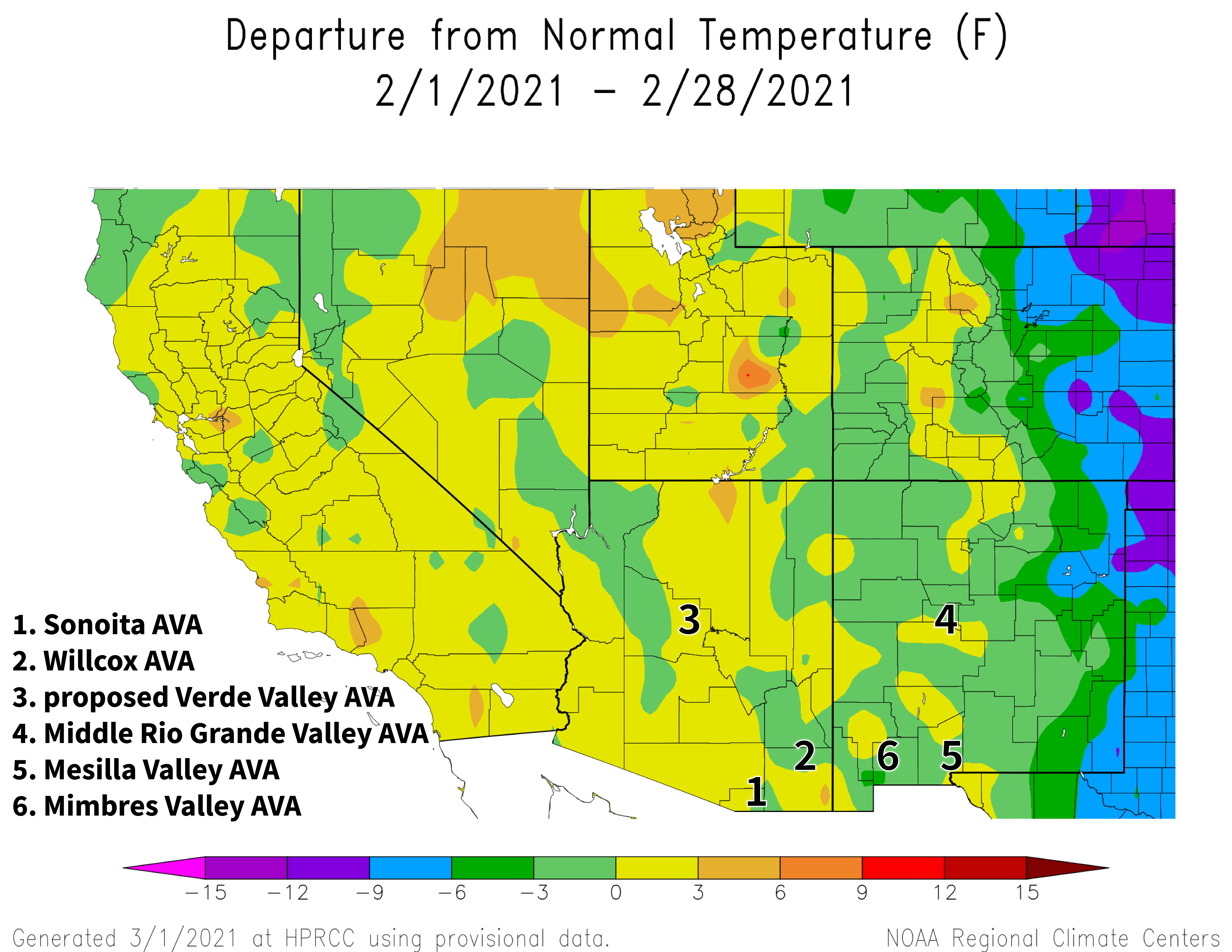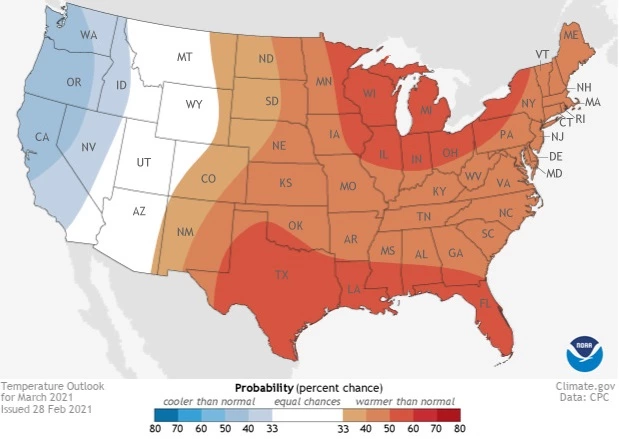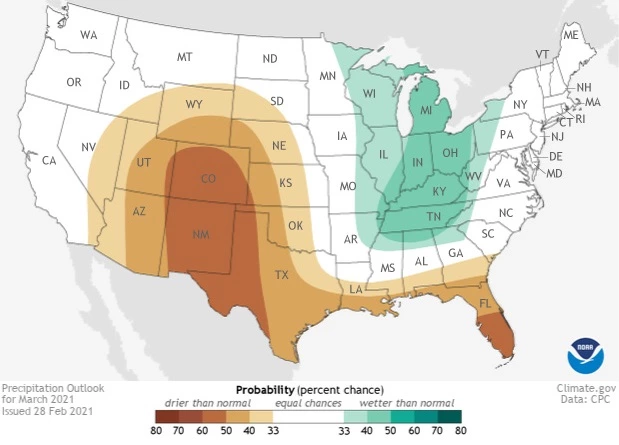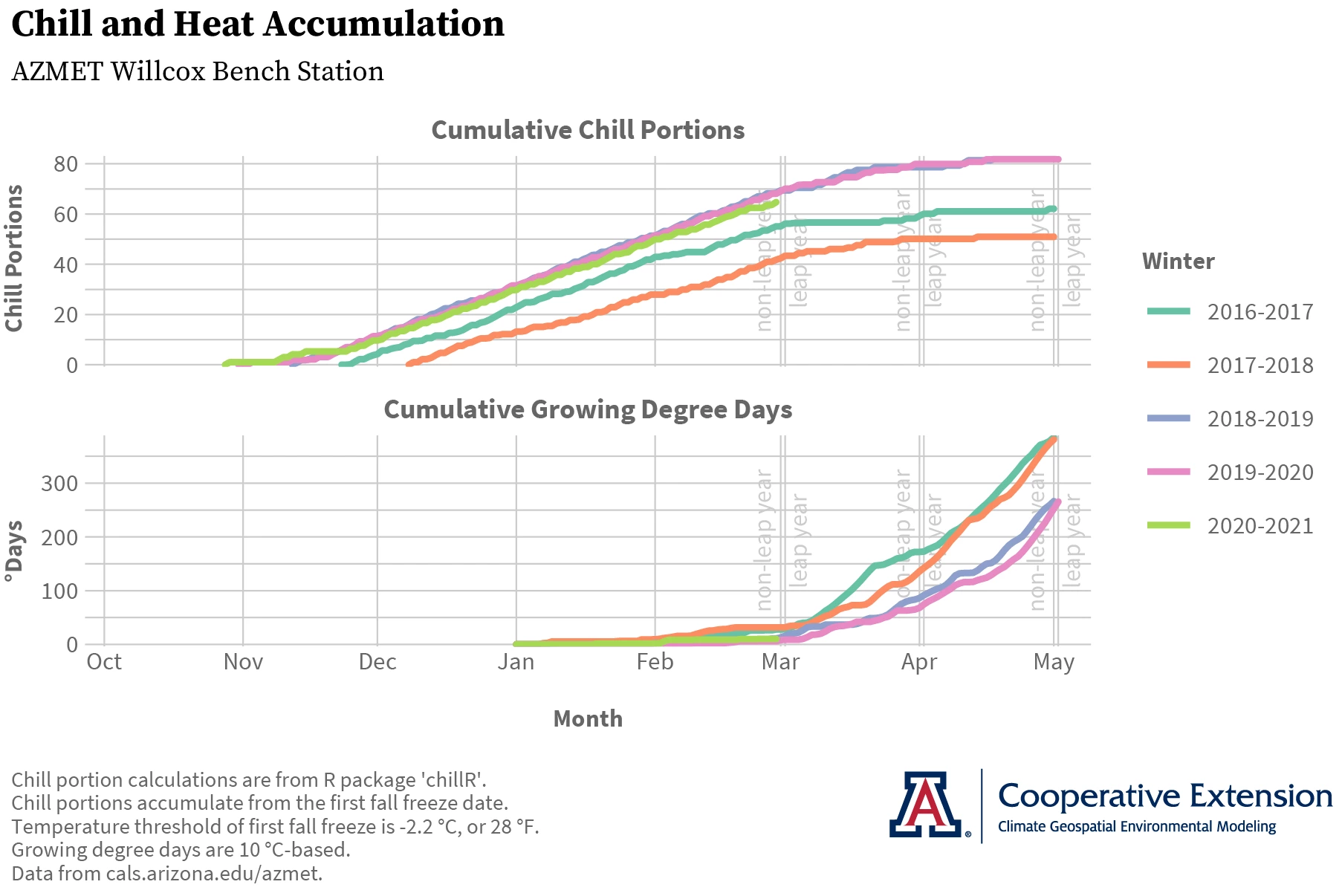< Back to Climate Viticulture Newsletter
Hello, everyone!
This is the March 2021 issue of the Climate Viticulture Newsletter – a quick look at some timely climate topics relevant to winegrape growing in Arizona and New Mexico.
A Recap of February Temperature and Precipitation
Average temperatures last month were within 3 °F of the 1981-2010 normal for almost all of the region (light green and yellow areas on map). Being on the periphery of the mid-month cold-air outbreak across the center of the country, far eastern New Mexico experienced monthly average temperatures 3 to 9 °F below normal (dark green and blue areas on map). As a comparison, temperatures in February last year were within 2 °F of the 1981-2010 normal across much of the region.

NOAA ACIS
Relatively dry conditions once again plagued much of the region, with monthly totals less than 50% of the 1981-2010 normal (dark orange and red areas on map). In contrast, a few areas scattered across New Mexico received near- to above-normal amounts (yellow, green, and blue areas on map). This is different from February of last year, particularly for growing areas in the southern half of the region, when monthly precipitation totals were above normal.
One upshot from last month is that temperatures did not move the needle much in terms of heat accumulation and its influence on bud break and the start of the growing season for warm-climate growing areas in the region. We’ll look more at this below. In terms of precipitation, we are simply left shaking our heads. Just how dry is it? If a recent summary from the Tucson forecast office of the National Weather Service is any indication, it’s really dry. Total precipitation from March 2020 through February 2021 ranks as the driest 12-month period on record, with just over 3.5 inches. Many other areas throughout the region also are posting record to near-record dry conditions over this time span. Close attention to soil moisture levels and irrigation this dormant season looks necessary to help guard against delayed spring growth.
View more NOAA ACIS climate maps

NOAA ACIS
The Outlook for March Temperature and Precipitation
There are equal chances for below-, near-, or above-normal temperatures for almost all of Arizona (white area on map). A slight increase in chances for above-normal temperatures exists for all of New Mexico (orange and light orange areas on map). Temperatures in March last year were near or up to 5 °F cooler than normal for much of Arizona, and near or up to 5 °F warmer than normal for much of New Mexico.

climate.gov
A slight increase in chances for below-normal precipitation exists for almost all of Arizona (light and dark tan areas on map), whereas a moderate increase in chances for below-normal precipitation exists for almost all of New Mexico (brown area on map). Monthly precipitation totals in March 2020 were near- or above-normal across much of the region, with a particular exception being northeastern New Mexico. In fact, most of Arizona and southern New Mexico recorded totals greater than twice the normal amount we would expect in March. Unfortunately, the odds do not look to be in favor of a repeat performance of such wet conditions over the next four weeks.
Without a strong signal of which way temperatures might lean for the rest of this month, it remains hard to say what their effect on heat accumulation and the start of the growing season will be from where the situation is right now, something we’ll take a look at in the next section. What is becoming easier to say for precipitation is that the current La Niña event is waning and that ENSO neutral – neither La Niña nor El Niño – conditions most likely return by late spring or early summer. Not that the need to irrigate will have much time to relax once the growing season is underway, however, as April, May, and June typically are relatively dry months for the region, regardless of what is happening in the tropical Pacific Ocean.
Read more about the March 2021 outlook

climate.gov
Vine Dormancy and the Start of the Growing Season
At the start of this month, values of both cumulative chill portions and cumulative growing degree days closely track those observed during the past two years, winters 2019-2020 and 2018-2019, at the AZMET Willcox Bench station in the south-central part of the Willcox AVA (green, pink, and blue lines on graphs). This suggests that chilling requirements – which can be different between varieties – were met and the switch from endodormancy to ecodormancy occurred on similar dates during these three years. Although the cumulative amount of chill portions corresponding to this switch for individual varieties is unknown, chilling requirements in general are low for grapevines and easily met in growing areas in Arizona and New Mexico. Vines remain in ecodormancy until environmental conditions become optimal for root activity and bud growth, a point commonly estimated by heat accumulation. Based on degree-day calculations from the National Phenology Network, heat accumulations for other warm-climate growing areas in the region also appear similar to those from this time last year.
Although it’s still early in the season for heat accumulation, things start to pick up during March, as shown by the lower graph. We’ll check back into this topic with a special newsletter issue in the middle of the month.

Jeremy Weiss
With much of our attention on phenology, we’re often reaching for a good diagram of grapevine growth stages to help us keep things straight. In case you misplaced yours, the Australian Wine Research Institute has a copy of the Modified E-L System on page 4 of this document. Bud break, or budburst, is Stage 4. Defining features are a green tip and visibility of the first leaf tissue.
Besides the start of the growing season, late March and early April also bring the climatological climatological last spring freeze to warm-climate growing areas in the region. For those of you in southeastern Arizona, Cooperative Extension manages an email listserv in coordination with the Tucson forecast office of the National Weather Service to provide information in the days leading up to such agriculturally important events. Please contact us if you'd like to sign up.
As in autumn 2019, the first fall freeze last year for several growing areas in the region occurred in late October when vines were not yet fully dormant and still running the risk of bud mortality from such temperatures. Dr. Gill Giese, Extension Viticulture Specialist with New Mexico State University, and Michael Dominguez of Think Wines recently assessed the impact of that event last autumn at a vineyard in Los Lunas, NM, south of Albuquerque. Scroll down just past half way in this eBulletin to see their results.
A recent donation of 40 acres near Willcox plus recent funding from the USDA-AZDA Specialty Crop Block Grant program are some of the first steps of a newly formed public-private collaboration towards a Viticulture Center of Research (VCOR) that will help support winegrape growing in Arizona. The funding will provide resources to convene the state viticulture industry and its supporters in the latter half of 2021 to determine common interests and develop plans for moving the VCOR project forward. Another first step is to gather letters of support that demonstrate backing of the VCOR project from the Arizona viticulture industry to relevant leaders in the University of Arizona. To learn more about the VCOR project and how to contribute a letter of support, please contact Joshua Sherman, commercial horticulture agent with University of Arizona Cooperative Extension.
Undergraduate students in the College of Agriculture and Life Sciences at the University of Arizona are looking for internships with businesses and companies in the viticulture and winery industries during 2021. Please contact Danielle Buhrow, Senior Academic Advisor and Graduate Program Coordinator in the Department of Agricultural and Resource Economics, for more information.
Please feel free to give us feedback on this issue of the Climate Viticulture Newsletter, suggestions on what to include more or less often, and ideas for new topics.
Did someone forward you this newsletter? Please contact us to subscribe.
Have a wonderful March!
With support from:




